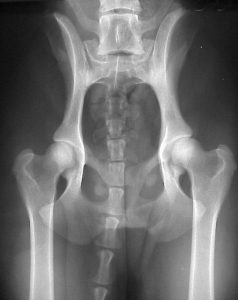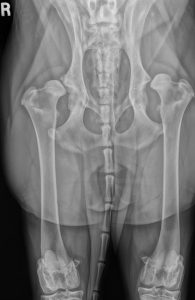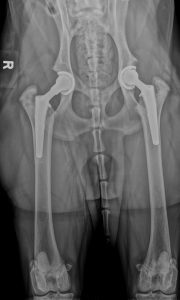Indications for Total Hip Replacement in Dogs and Cats

Total hip replacement (THR) in dogs and cats is most commonly performed to restore a pain-free joint and normal function due to pain resulting from osteoarthritis (OA), often secondary to hip dysplasia. Other causes of arthritis, such as hip trauma, genetic developmental problems, abnormal growth of the hip, are also indications for THR. The clinical signs of hip arthritis often are the same regardless of the underlying cause. These include limping, slowness to rise, hesitancy to jump up, a “bunny-hopping” gait, lack of desire to go for long walks, contentment to be an observer instead of a participant in vigorous activity and many more often subtle hints of discomfort.
Potential THR Surgery Candidates
Not all animals presenting with hip pain are imminent THR candidates. Non-surgical pain management is generally the first option recommended before surgery. If pain management is only partially effective, if clinical signs worsen or if ongoing pain management is indefinitely necessary, surgery is indicated. Pain management coupled with attaining an ideal body condition scorean assessment of the animal's weight for age and weight for height ratios, and its relative proportions of muscle and fat may delay surgery in some instances, but weight reduction and exercise are sometimes difficult to achieve when the hips are painful. If uncomplicated, unrelenting hip pain is present affecting your pet’s quality of life, your veterinarian will likely recommend THR surgery, which will restore a pain-free joint with normal function for the life of your companion.
Common Hip Conditions that Benefit from THR
In large-breed dogs (and small breeds and cats as well), arthritis secondary to hip dysplasia is the most common indication for THR. Other problems such as hip luxation (hip out of joint due to trauma), avascular necrosis of the femoral head (a developmental genetic condition in which the blood supply to the femoral head is inadequate, causing deterioration) and certain hip fractures are other common indications. Total hip replacement is becoming more common in cats and small-breed dogs. In one article, hip luxation, avascular necrosis and fractures were the respective indications for 23 percent, 26 percent and 17 percent of the hip replacements in small-breed dogs and cats (Liska 2010). Scientific literature articles also report the use of THR for the treatment of certain fractures and for avascular necrosis of the femoral head (Jankovits et al. 2012; Kalis et al. 2012). THR also has been performed to manage unsuccessful femoral head ostectomy (FHO, a previous surgery where the ball of the ball-in-socket joint was removed). (Liska et al. 2010). Unfortunately, this kind of revision surgery from a FHO to a THR is often not possible.
Additional Factors Determine THR Candidacy
Patient age is an important consideration both anatomically and physiologically. Ideally, the animal has reached skeletal maturity (closed growth plates) at about nine to 10 months of age prior to surgery. In some circumstances, THR surgery can be performed as early as six months of age. Surgery must be delayed in immature animals until the growth plates on the pelvis side of the hip joint are closed. Surgery prior to closure of the growth plate on the femoral head (ball part of the hip joint) does not cause a problem. The status of the growth plates at the lower end of the femur near the knee is inconsequential because those growth plates are not disrupted during THR surgery.
Young Dogs with Hip Dysplasia Benefit Most from THR
The stage of hip dysplasia seen in dogs presenting between the ages of 10 to 12 months is good timing for surgery. A favorable window of opportunity exists in dogs with severe hip dysplasia at a young age. It is generally recommended to conduct surgery in the early stages of arthritis development rather than waiting until arthritis has become severe, advanced or end-stage. Arthritis secondary to hip dysplasia never improves with age. Chronic hip dysplasia can result in extensive anatomical changes of the bones and joint, making surgery more difficult. Muscle atrophy and muscle contracturetightening or shortening of muscles due to chronicity also make the surgery more difficult and prolong recovery.
Concurrent Conditions Distort Clinical Signs and Severity of Hip Dysplasia
Concurrent orthopedic and neurological diseases are sometimes present in animals that are THR surgery candidates. These conditions may exacerbate the clinical signs of hip dysplasia or may lead one to incorrectly attribute the severity of the clinical signs to the hip joint. Some spinal and neurological problems produce clinical signs similar to severe bilateral arthritis from hip dysplasia.
A thorough physical examination, including a neurological examination, is done to rule out or identify concurrent disease conditions prior to surgery. Concurrent neurological or orthopedic diseases must be carefully assessed. Until these conditions are resolved or evaluated in light of the patient’s overall condition or function, they may necessitate postponement of THR surgery.
It is not unusual for hip arthritis to be present with other orthopedic conditions, such as medial patella luxation (MPL, or knee cap popping out) or anterior cruciate ligament (ACL) injury. When concurrent hip and knee problems are suspected, it must be determined whether clinical signs (lameness and/or pain) originate at the hip, the knee or both. If both joints are responsible for clinical signs, the hip and knee procedures are sometimes performed one at a time, with the knee problem usually a higher priority.
Assessment of Patient’s General Health Also Determines Eligibility for Surgery
Serious and often life-threatening medical conditions must be ruled out. Patients with general illness must be treated with caution. Examples include uncontrolled skin infection, cancer, blood clotting problems and heart, liver or kidney failure managed by medication. Likewise, the overall effects of other comorbidities, such as diabetes mellitus, Cushing’s disease, immune-system suppression and thyroid dysfunction may pose a significant risk to the THR patient. A thorough preoperative assessment is completed when an interest in THR surgery is expressed, even after successful treatment of these or similar diseases. Preoperative lab testing and radiographs are completed before anesthesia and surgery to determine if other health problems exist.
Joint infection is an absolute contraindication for hip replacement surgery. The presence of hindquarter or generalized dermatitis, ear infection, urinary tract infection and dental disease must be resolved prior to surgery.
Cancer, with or without spread to the rest of the body, is a relative contraindication to THR surgery. Occasionally, some forms of bone cancer that are highly localized to the hip joint may not be a complete contraindication. It is sometimes feasible to implant a custom-made prosthesis in selected cases. Follow-up cancer therapy may also be indicated in those patients.
Less Expensive, Alternative Surgery Comes with Unpredictable Results
When financial constraints preempt THR surgery, a femoral head and neck ostectomy (FHO) might be an option in selected cases. An FHO carries the risk of not achieving acceptable pain relief or restoration of function in both large- and small-breed sizes (Off W, Matis U: VCOT 23:297-305 2010). An FHO disrupts the normal ball-in-socket function, results in limb leg length (shortening) discrepancy and unpredictable pain relief and may require prolonged rehabilitation (Liska et al. 2009). After FHO, objective data indicates that some animals are slightly improved, some have no improvement, and some are worse. Unfortunately, the results are not predictable in advance of this surgery. Subjective observational reports following FHO suggest better results than objective data. In some cases, it is possible to revise a painful FHO to a THR, but an FHO is only rarely the best option for the animal and should never be advised as an interim “bridge” procedure prior to THR. FHO is most commonly the option when financial constraints preclude THR surgery. The results from a salvaged FHO procedure for a persistently painful hip must be explained, understood and acceptable to the animal owner.
THR Surgery Ensures Pets Enjoy a Pain-Free, Functional Life
THR surgery is a highly successful procedure that restores a pain-free joint with normal function. There are many dogs and cats that can benefit from this procedure. If clinical signs are present and the animal is at skeletal maturity (nine to 10 months of age), there is no reason to delay the surgery while the arthritis worsens. The implants do not wear out in a pet’s lifetime so the animals do not need to wait in pain until the arthritis is more advanced.
References:
Liska WD, Doyle ND: Micro total hip replacement for feline and small canine patients: Surgical technique and outcomes. Veterinary Surgery. 39:797-810 2010
Jankovits DA, Liska WD, Kalis RH: Treatment of avascular necrosis of the femoral head in small dogs with micro total hip replacement. Veterinary Surgery 41:143-147 2012
Kalis RH, Liska WD, Jankovits DA: Total hip replacement as a treatment option for capital physeal fractures in dogs and cats. Veterinary Surgery 41:148-155 2012
William Liska, DVM, is a graduate of Iowa State College of Veterinary Medicine. Dr. Liska founded and now dedicates his career to Global Veterinary Specialists and the Global Veterinary Specialists Foundation.





